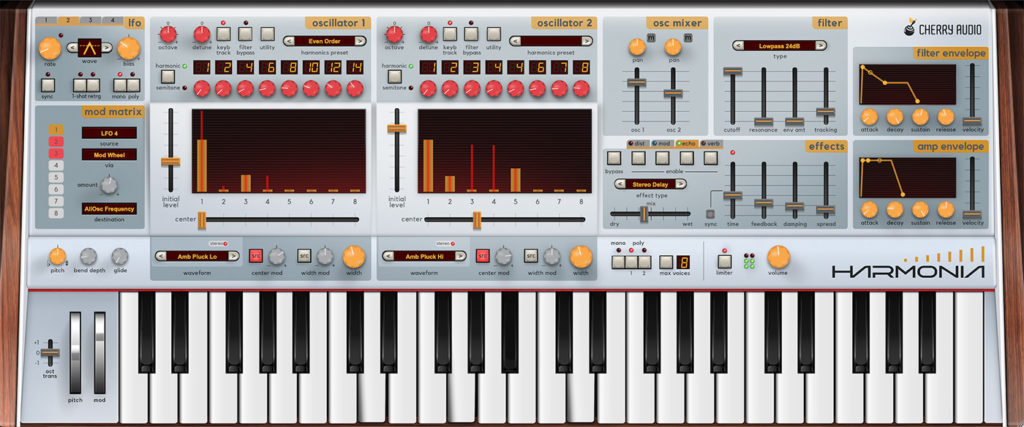Almost half an hour of music already done for the 18EDO album. It varies from percussive gamelan-like stuff to drones, but it all seems to work out pretty well. It’s been fun, but the choice to use that tuning system is kind of a restriction both creative and technical, and it’ll be good to leave it behind again in the future.
Let’s talk about Cherry Audio. They have a lot of cheap software synths, most of which are emulations of classic analog designs, and a few effects. They also have Voltage Modular, which I thought was limited in a lot of ways that “real” modular isn’t when I tried it.
A common position toward any emulation on KvR is that whatever it is, it’s terrible and doesn’t sound like the real thing. You’ll find people saying that about nearly any emulation, and I think there’s a kind of groupthink aspect to it where people will pile on to show that they have discerning ears. I never really take any of that seriously, because — with some exceptions — I’m not familiar enough with the exact piece of gear to really judge and also I usually care more about whether it sounds interesting than if it sounds identical to something. Honestly, my opinion of their stuff is most of it sounds okay (ranging into “cool” in some cases) but not necessarily spectacular.
But one criticism of Cherry Audio that I definitely share is about their UI design.
I don’t care for arguments about skeumorphic vs non-skeumorphic designs… if you want the interface to look like a piece of hardware with knobs, sliders, wooden sides etc. that’s fine, as long as you don’t ask me to imitate rotating the mouse around a knob to turn it. And it makes sense to use that sort of design when emulating a classic piece of gear.
But where it comes to layout… a lot of that gear was 4- or 5-octave full-sized keys, which makes it pretty long, and sometimes the rest of the control panel might have wasted space. That’s not good for putting on a screen, along with several other windows jockeying for position. So a lot of plugin developers take the liberty of rearranging things, while still preserving the visual language and aesthetics of the original gear.
Plus, there’s not really much benefit in drawing a keyboard on the screen when you’re going to be using a real one or a sequencer. Clicking on the keys is of limited musical usefulness, though maybe if you have a touchscreen it’s a little better. Still, most developers either skip the keyboard or let you disable it.
CA cares not about these things. No option to disable the keyboard. No rearranging the controls to fit better. Instead, they have a “Focus” button that lets you zoom in and look at the thing with a magnifying glass. I find this really awkward and a sign of poor design choices.
Okay, but that’s them just being a little overly faithful to the classic synths, right? They wouldn’t do that with their own original synths that only exist as VST plugins, would they?
…they would. Here is Sines:

I wanted to love this one. It’s based on phase modulation and waveshaping! But I just could not with this UI. Look at how busy it is… you HAVE to zoom in to be able to use it. They really should not have tried to force all 4 oscillators as well as 4 LFOs and 4 envelopes and the other stuff and the silly keyboard and the other wasted space into one screen. Tabs are your friend! But also, honestly, the synthesis methods here are something I can and do patch together very readily with Bitwig Grid or with my modular hardware. So I took a pass.
Here’s their latest just released today, Harmonia:

It is a lot less cramped and it’s pretty visually appealing. But still, this is not an ideal layout, especially for a synth that’s a fresh original concept and not an imitation of a piece of hardware. Here’s what I would do:
- Eliminate the keyboard and pitch/mod wheels.
- Go with a two-row design, oscillators on top and the LFOs, envelopes, mod routing and FX on the bottom row. Overall the aspect ratio would be more square.
- Instead of an “Osc Mixer” just put the level/pan controls with their associated oscillators.
- The envelopes should be sliders. Sliders are traditional for ADSR envelopes and easy to read, there’s no need to use knobs and graphical envelopes. Minor nitpick because it’d still take a similar amount of space, but it seems inconsistent.
- Control range/response for the distortion could use some work I think. With the sort of complex sounds the engine produces, it doesn’t take much distortion to go overboard.
- This is less strictly about UI, but I feel like one filter isn’t quite enough, or the osc sections maybe need simple lowpass filters built in.
Another disappointment outside the UI is that it doesn’t support MPE, and you can’t load alternate tuning files (e.g. Scala), and the pitchbend range is limited to 12 so it won’t work well with Bitwig Micro-Pitch — it can kind of do its thing monophonically but the pitch wobbles into place.
But! This is an interesting synth overall. It takes the harmonic oscillator concept but lets you retune each partial to different intervals, with some useful preset options. And instead of sines, you get samples/wavetables to work with. And you can modulate a lot of stuff at audio rate from one of the oscillators. Altogether, this allows for some very busy, very dirty, but controllable sounds and I’m really digging that.
I meant to write more stuff but I’ve just been playing with it for the last hour, so… yeah, gonna grab it despite its flaws.



